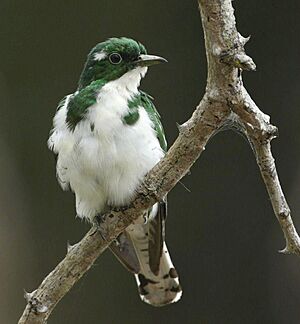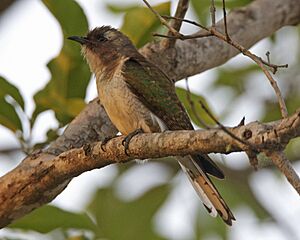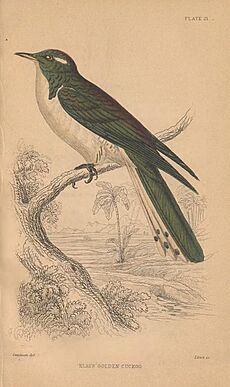Klaas's cuckoo facts for kids
Quick facts for kids Klaas's cuckoo |
|
|---|---|
 |
|
| male | |
 |
|
| female | |
| Conservation status | |
| Scientific classification | |
| Genus: |
Chrysococcyx
|
| Species: |
klaas
|
The Klaas's cuckoo (scientific name: Chrysococcyx klaas) is a type of cuckoo bird. You can find it in the forests and woodlands of sub-Saharan Africa. This bird was named after a Khoikhoi man named Klaas, who helped find the very first bird of its kind.
Why is it Called Klaas's Cuckoo?
This cuckoo got its name from a special person. A French explorer named François Le Vaillant first described the bird in 1806. He named it in honor of his assistant, a Khoikhoi man named Klaas. Klaas was the one who found the first example of this bird.
Le Vaillant wanted future scientists to remember Klaas's help. His wish came true! In 1815, James Francis Stephens officially gave the bird its first scientific name, Cuculus klaas. The name "Klaas" has stayed with the bird ever since.
This bird is important because it was the first time a species was named after an Indigenous person. Le Vaillant was also the only explorer from that time to name birds after local people.
Where Does it Live?
The Klaas's cuckoo lives all over sub-Saharan Africa. However, you won't find it in the very dry desert areas in the southwest. It prefers places with trees and bushes.
What Does it Look Like?

Klaas's cuckoo is a small bird, about 16 to 18 centimeters (6 to 7 inches) long. Male and female cuckoos look different, which is called sexual dimorphism.
Male Klaas's cuckoos have shiny green bodies. They have very few markings and plain white feathers on their undersides. When they fly, you mostly see white with dark wingtips.
Female Klaas's cuckoos are bronze-brown. Their wing feathers have a greenish color. Their white undersides have faint stripes. When females fly, they look mostly brown.
Both male and female cuckoos have a small white patch of feathers behind their eyes.


